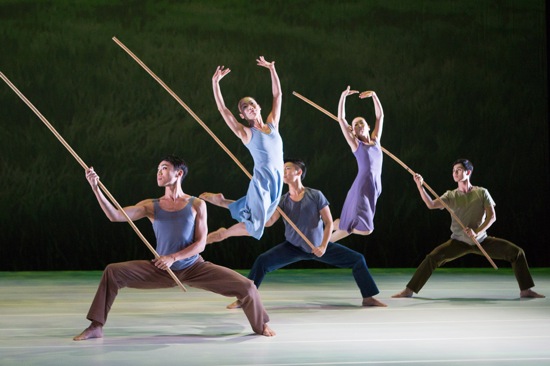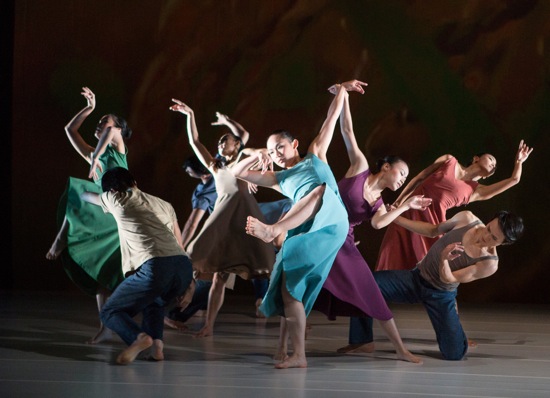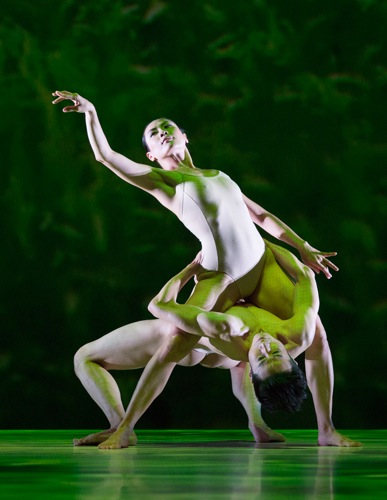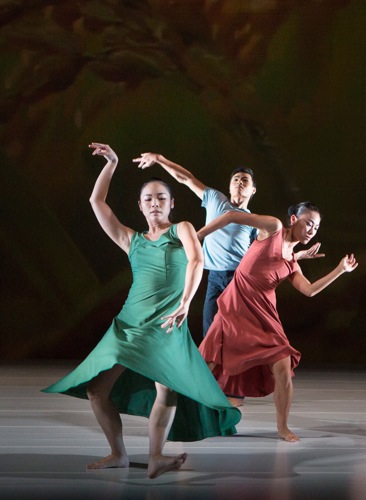Cloud Gate Dance Theatre of Taiwan comes to the Brooklyn Academy of Music with Lin Hwai-min’s “Rice.”

The “Sunlight’ section of Lin Hwai-min’s Rice. In air (L to R): Liu Hui-ling and Su I-Ping; with sticks (L to R): Hou Tang Li, Wong Lap-cheong, and Huang, Lu-kai. Photo: Yi-Chun Wu
When Lin Hwai-min brought his Cloud Gate Dance Theatre from Taipei to the Brooklyn Academy of Music’s Next Wave Festival in 2000, one performer stood in a near corner of the stage all through Songs of the Wanderers while gold-dyed rice streamed down on his head and pooled around him. That was neither the first time nor the last that Lin—who grew up in a Taiwanese village in whose immense rice field he and his childhood friends played—would choose this vital source of food as the subject of a dance.
Lin doesn’t do things by half. In preparing Rice, which premiered in 2013 in celebration of Cloud Gate’s 40th anniversary, he and his 24 dancers went to the Chihshang region of Taiwan, rose at 5 A.M., and joined in harvesting the rice. Their minds and bodies received silent messages from the soil, the sun, the wind. Then Lin set about choreographing the piece.
These are extraordinary dancers. I believe I’ve watched them perform all six times they’ve appeared at BAM. I’ve also seen them in Taipei in a class taught by a master of Tai Chi Tao Yin (an ancient form of Qi Gong). They study other martial arts forms and meditation, as well as modern dance and ballet. There is something deeply grounded about them, immensely controlled, yet also flexible and responsive to change. Sometimes you imagine a wind blowing their limbs or water coursing through them. Yet many of the rhythms in Lin’s work derive from martial arts—the slow drawing- together preparation and then a sudden drop into a wide, braced position. Such moves make me think too of the drawing of a bowstring and the sudden, whirring release of an arrow.

Cloud Gate dancers in the “Pollen I” section of Rice. (L to R): Lee Tzu-chun, Wang Po-nien, Wong Lap-cheong (partly hidden), Huang Li-chieh (mostly hidden), Chen Mu-han (in beige) Yeh Yi-ping (in light blue, front), Fan Chia-hsuan (in purple), Kuo Tzu-wei, and Lin Hsin-fang. Photo: Yi-Chun Wu
Rice acknowledges the annual cycle of the crop in sections titled “Soil,” “Wind,” “Pollen I,” “Pollen II,” “Sunlight,” “Grain,” “Fire,” “Water.” You, of course, see the dancers as the people that they are, but the forms and the dynamics of what they do suggest a kinship with the life of the crop itself. Every year, the rice paddy’s soil must be readied, the shoots planted, and the field flooded. Sun and wind encourage growth. Then comes pollination and, in time, the harvest, the draining of the fields, the burning of the dried stalks, and the renewing water.
Projected videos by Howell Hao-jan Chang, aided by projection designer Ethan Wang, fill the stage’s backcloth with gorgeous images of the valley and the mountains behind it and, more importantly, of water rushing over small green shoots, of taller and then even taller plants bending and rippling in the wind like waves of green. Stalks of budding rice loom over the dancing, and then fire takes over the field, crackling here and there and gradually blazing up to consuming the cut-off stems.
Rice begins quietly with only distant sounds. When a man crosses the stage in a path of light (by Lulu W.L. Lee), holding a long, slim bamboo pole parallel to the floor and making the stick vibrate, we can almost hear its whirring. A woman appears. She (Yang I-chun) plants her feet a little apart, slowly rises onto tiptoe, and then drops her heels down again, her bare feet hammering the ground. She does this over and over, gradually advancing along a diagonal path. One by one, other women join her in this task, facing different directions, but adhering to the strong rhythms she has set. Eventually, they will clump together to continue, like a human machine tamping down the soil.
Lin is wonderfully skilled at manipulating movement, whether simple or complex. He shows us individuals feeding into a group, as in this first scene. He brings people into unison or counterpoint or sets them doing the same phrase at different times. He scatters them as if by wind. Sometimes the marvelous dancers move slowly, slowly, as they do in a strangely erotic duet performed by Huang Pei-hua and Tsai Ming-yuan. They begin on the floor, each reaching out with one leg to touch the other’s toes. The positions they flow into are intimate but unusual, almost more evocative of entities merging than humans copulating. In “Grain,” a woman (Chou Chang-ning) sits balanced on her tailbone, her feet climbing up the air, toes spread. Seven women surround her, twitching in different ways both small and large.
Eventually, as flames leap across dry spaces in the video, nine vault in acrobatic ways over the bamboo poles that they hold, falling into the rhythms of martial arts: a burst of rapid moves, say, is followed by a strong pose, as if it were the period at the end of a sentence. And then, for the final “Water,” the women enter one or two at a time with bent-forward walks, as if heavy-laden, their arms dangling or clasped behind them; they seem as dry as charred, chopped-off plants shown on the screen. The last image is of a single woman (Yang I-chun) alone on stage signaling the coming of the water that rushes down in the video behind her.
Lin’s choreography includes a few images we associate with western modern dance—men lifting and swinging women, men flying by in leaps with straight legs, for example. Other moves, such as dancers circling the stage with a smooth patter of tiny steps, remind me of female roles in traditional Japanese theater. Lin’s style, however, is primarily of the earth, with angularity and crookedness vying with curves. The dancers of Cloud Gate convey flexibility within rootedness, and their mostly serene intensity is not a theatrical addition but part of their daily practice.
Costume designers Ann Yu Chien and Li-Ting Huang have garbed the women in plain, but skillfully cut dresses in various colors and the men in unpretentious pants and shirts. It’s surprising how well Lin’s eclectic choices of music work with the choreography. Near the beginning of Rice, you hear what sounds like an old man’s voice singing a traditional folk song in Hakka, one of China’s ancient dialects. Later Maria Callas sings “Casta Diva.” An excerpt from Mahler’s Symphony No. 3 is heard at the end. Strangely, all of it seems to fit. Heavy drum beats, too, are at home in a soundscape recorded in the field—one in which thunder rumbles, water gushes, and grain rustles in the wind.



Deborah,
This is a beautifully written review of a compelling dance company and recent work. How I wish I could actually see them perform! But your evocative review takes me into the work all the same. Perhaps we can encourage them to come to Cincinnati & perform in our Contemporary Dance Company?
Thanks.
Jodine Grundy